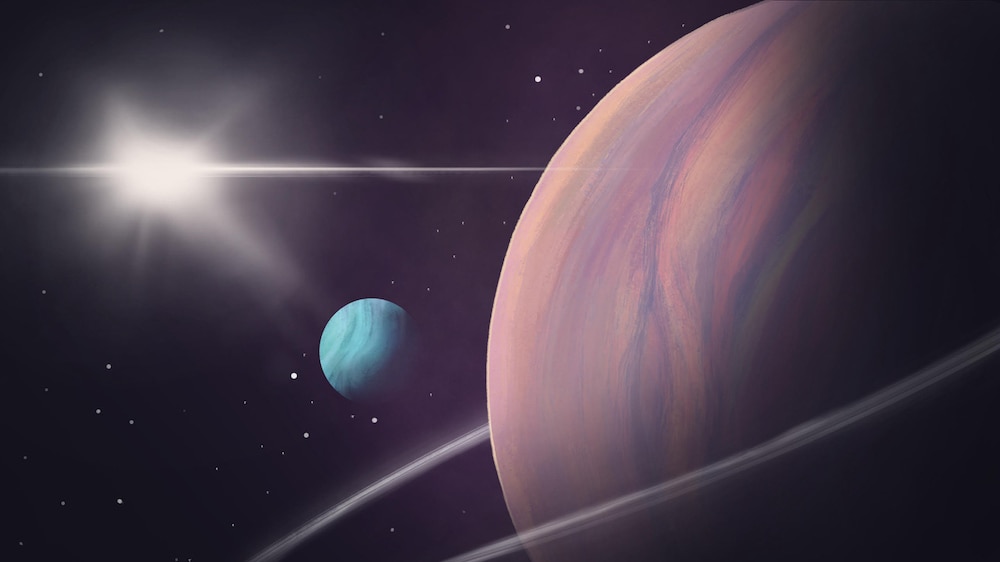Create a free profile to get unlimited access to exclusive videos, sweepstakes, and more!
Which exomoons could possibly be crawling with life?
If some moons in our solar system might be habitable, then...

If the exoplanet which the crew of that spaceship in Star Runners crashed on had exomoons, they would possibly have even more insectoid aliens to worry about.
Exomoons outside of science fiction have been suspected, but not yet detected. They have to exist, though — at least they should if other star systems formed like our solar system, and there are enough stars out there which are orbited by planets that were probably born the same way. So if there are planets beyond our cosmic realm that formed like the planets surrounding us, researchers now think that their (hypothetical) moons should have also formed like the moons of those planets. Some of the moons we know could be habitable. So could exomoons.
But how do you search for something that even the most powerful telescopes can barely see? A research team from the University of Groningen in the Netherlands and the University of Helsinki in Finland have now figured out which planets are not only likely to have exomoons, but potentially habitable exomoons. This doesn’t necessarily mean they’re crawling with Star Runners' giant bugs that live under radiation shields. Life could mean anything from primitive microbes to something far more intelligent than even humans can begin to imagine.
“This study focuses on big, rocky exomoons that are capable of maintaining a significant atmosphere,” whose habitability could be determined by “incident stellar radiation and the tidal heating flux,” the team said in a study recently published in Monthly Notices of the Royal Astronomical Society.
Getting an idea of whether a hypothetical exomoon could have spawned life means figuring out how much radiation hits it and how tidal forces affect heat. Take Jupiter’s moon Io. It is pulled at by the gravitational forces of its sister moon Europa. Its orbit would be circular if it wasn’t for Europa pulling that path around Jupiter into an ellipse. That means that Io’s distance from Jupiter doesn’t remain the same as it would in a circular orbit, but always changes, meaning the tidal forces exerted on it also change. Its orbit is so short that it generates internal friction which results in tidal heating. No wonder Io is always having volcanic outbursts.
It is possible that tidal forces could have also heated Earth when it was still young. Going back to the Jovian system, Europa, which is being seriously looked at as a candidate for extraterrestrial life, also experiences tidal heating to some degree because of its position between Io and Ganymede. It is possible that is heating the depths of its vast subsurface ocean and making at least parts of it survivable. Maybe Europa Clipper will find out.
Figuring out which exoplanets are most likely to have moons in orbit meant factoring out many of them. Using the Extrasolar Planets Encyclopedia, the researchers decided to focus on planets smaller than 13 Jupiter masses which had a host star that was at least .08 solar masses. The orbital period and axis of these planets needed to be known, as did the likely mass, minimum mass, and radius. For each of 4,140 known exoplanets, the team simulated 100,000 moons, and they ended up with 234 exoplanets where hypothetical moons were at least 1% likely to be habitable. 17 of the actual planets had an over 50% chance.
But wait. There is still one thing that could drastically change these results, and that is the host star of any given planet. The type of star most of these planets are orbiting is not listed in the Extrasolar Planets Encyclopedia, and there is no phase of evolution for stars that are in there. Meaning, some of the supposedly viable candidates for habitable exomoons might be getting torched by the radiation of a powerful star that flares all the time, which makes it nearly impossible for life (at least as we know it) to exist.
At least for now, the three exoplanets most likely to be orbited by exomoons are Kepler-549 b, Kepler-546 b, and HD 7199 b. Kepler-549-b is slightly smaller than Jupiter and takes 854 days to orbit a Sun-like star. It has a 70% chance of habitable exomoons. Kepler-456-b is another planet just under Jupiter mass that orbits a star as massive as the Sun every 1,320 days. HD 7199 b is a gas giant that has the longest orbit of all, 1.7 years, around a Sun-like star. The probabilities for habitable exomoons around these two planets are 69% and 64%.
So maybe these exoplanets couldn’t’ sustain life because they are gas giants, but if Jupiter and Saturn’s moons have anything to say, something might be lurking there.














